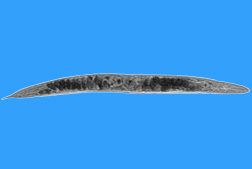This page has been archived and is being provided for reference purposes only. The page is no longer being updated, and therefore, links on the page may be invalid.
| Read the magazine story to find out more. |
|
|
Nematodes with Pest-Fighting Potential Identified
By Jan SuszkiwAugust 20, 2012
Formosan subterranean termites could be in for a real headache. U.S. Department of Agriculture (USDA) scientists have identified species of roundworms, or "nematodes," that invade the termite brains and offer a potential bio-based approach to controlling them. Other nematodes that were identified invaded tarantula brains.
The Formosan termite, a nonnative species from Asia, feeds on cellulose from the heartwood of trees, the wood support beams of buildings, and other sources. It causes an estimated $1 billion annually in U.S. damages, repairs and control costs.
Biologically based control of the pest isn't a new concept, but the nematode species examined thus far do not kill the termites efficiently, according to Lynn Carta, a plant pathologist with the Nematology Laboratory, operated in Beltsville, Md., by the Agricultural Research Service (ARS), USDA's chief intramural scientific research agency.
Since 1999, Carta has determined the identities of seven species of nematode isolated from the bodies of Formosan termites by Ashok Raina, a retired entomologist formerly with the ARS Southern Regional Research Center in New Orleans, La. Other specimens Carta has identified were collected from dead or sick termites native to Uzbekistan. Further details appear in the International Journal of Nematology.
Of particular interest to Carta and colleagues are bacteria that have a symbiotic association with the nematodes. In one case, a Poikilolaimus nematode species and bacterial "accomplice" were isolated from the heads of Formosan termites, and it's likely the microbe had sickened the insects in the field. According to Carta, the bacterial association raises an interesting prospect: using nematodes as vectors of insect pathogens rather than as primary biocontrol agents—the traditional approach.
In another case that's still under investigation, Carta implicated a Panagrellus nematode species in the death of pet tarantulas. She suspects an insect and yeast may also be involved and is intrigued by the possibility because it would reveal a new ecological association that could yield novel approaches to pest control.
Read more about the research in the August 2012 issue of Agricultural Research magazine.

